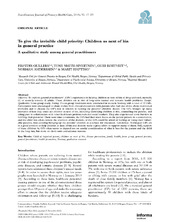| dc.contributor.author | Gullbrå, Frøydis | en_US |
| dc.contributor.author | Smith-Sivertsen, Tone | en_US |
| dc.contributor.author | Rørtveit, Guri | en_US |
| dc.contributor.author | Anderssen, Norman | en_US |
| dc.contributor.author | Hafting, Marit | en_US |
| dc.date.accessioned | 2017-06-07T08:37:23Z | |
| dc.date.available | 2017-06-07T08:37:23Z | |
| dc.date.issued | 2014 | |
| dc.identifier.issn | 0281-3432 | |
| dc.identifier.uri | https://hdl.handle.net/1956/15933 | |
| dc.description.abstract | Objective. To explore general practitioners’ (GPs’) experiences in helping children as next of kin of drug-addicted, mentally ill, or severely somatic ill adults. These children are at risk of long-term mental and somatic health problems. Design. Qualitative focus-group study. Setting. Focus-group interviews were conducted in western Norway with a total of 27 GPs. Participants were encouraged to share stories from clinical encounters with parents who had one of the above-mentioned problems and to discuss the GP's role in relation to helping the patients’ children. Results. The GPs brought up many examples of how they could aid children as next of kin, including identifying children at risk, counselling the parents, and taking part in collaboration with other healthcare professionals and social workers. They also experienced some barriers in fulfilling their potential. There were time constraints, the GPs had their main focus on the patient present in a consultation, and the child was often outside the attention of the doctors, or the GPs could be afraid of hurting or losing their vulnerable patients, thus avoiding bringing up the patients’ children as a subject for discussion. Conclusions. Norwegian GPs are in a good position to help children as next of kin and doctors make a great effort to support many of them. Still, support of these children by GPs often seems to depend not on careful consideration of what is best for the patient and the child in the long run, but more on short-term convenience reasons. | en_US |
| dc.language.iso | eng | eng |
| dc.publisher | Taylor & Francis | eng |
| dc.relation.ispartof | <a href="http://hdl.handle.net/1956/15936" target="_blank">Children as next of kin and the general practitioner. A qualitative study about the general practitioner’s opportunities to help</a> | |
| dc.rights | Attribution CC BY | eng |
| dc.rights.uri | http://creativecommons.org/licenses/by/3.0 | eng |
| dc.subject | Child of impaired parent | eng |
| dc.subject | children as next of kin | eng |
| dc.subject | disease prevention | eng |
| dc.subject | family health | eng |
| dc.subject | focus group | eng |
| dc.subject | General practice | eng |
| dc.subject | general practitioner | eng |
| dc.subject | health promotion | eng |
| dc.subject | Norway | eng |
| dc.subject | Qualitative research | eng |
| dc.title | To give the invisible child priority: Children as next of kin in general practice. A qualitative study among general practitioners | en_US |
| dc.type | Peer reviewed | |
| dc.type | Journal article | |
| dc.description.version | publishedVersion | en_US |
| dc.rights.holder | Copyright 2014 Informa Healthcare | |
| dc.identifier.doi | https://doi.org/10.3109/02813432.2014.874133 | |
| dc.identifier.cristin | 1154734 | |
| dc.source.journal | Scandinavian Journal of Primary Health Care | |
| dc.source.40 | 32 | |
| dc.source.14 | 1 | |
| dc.source.pagenumber | 17-23 | |

